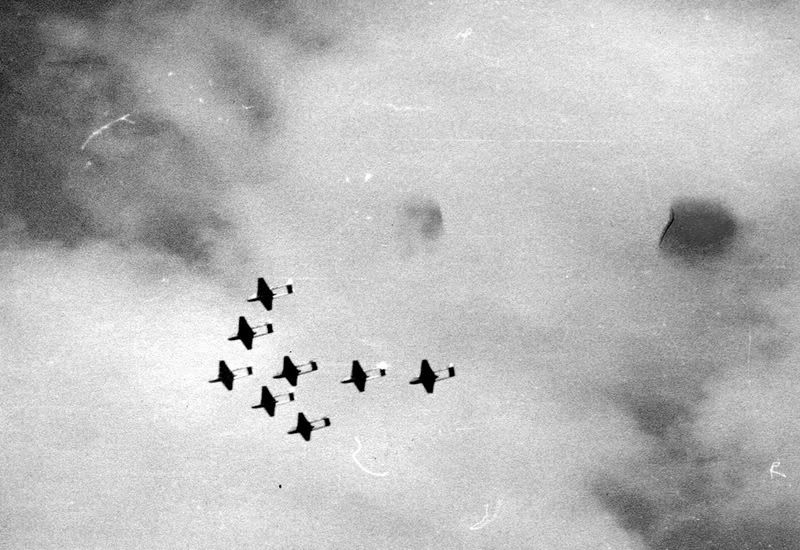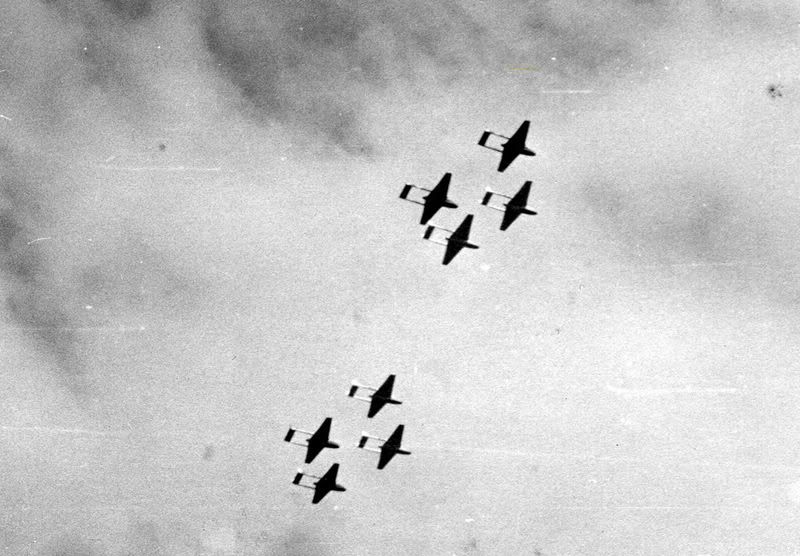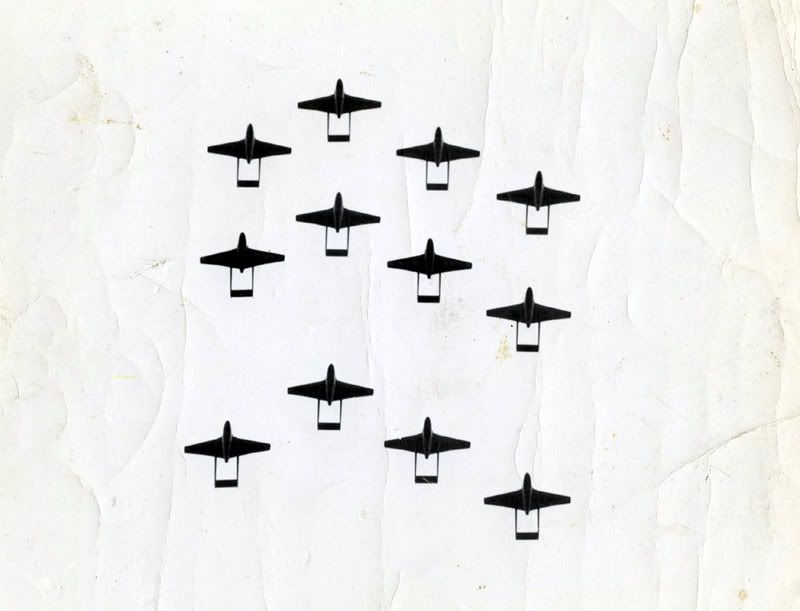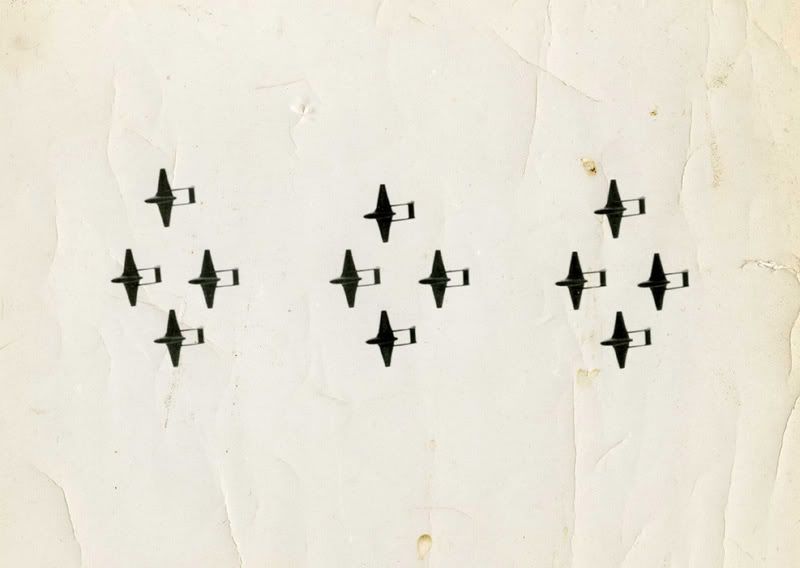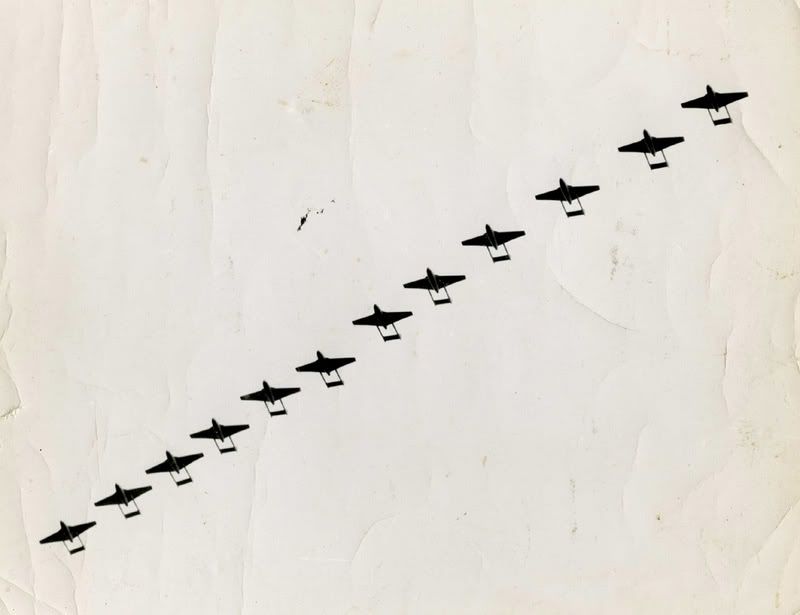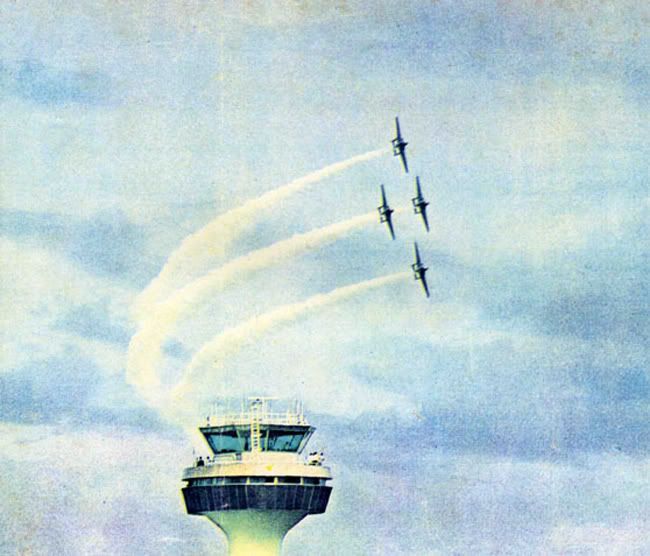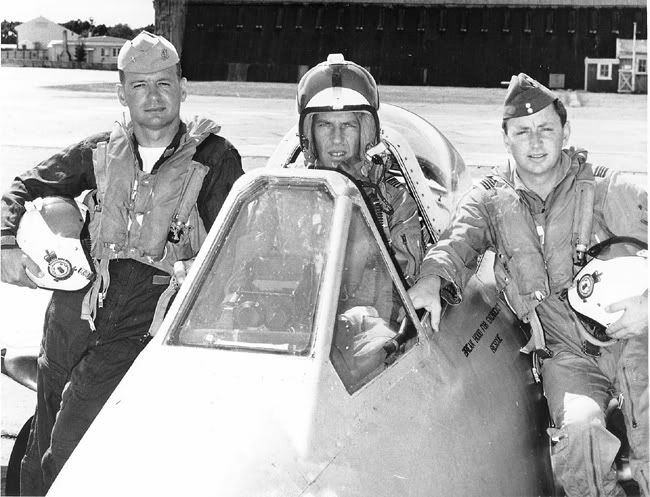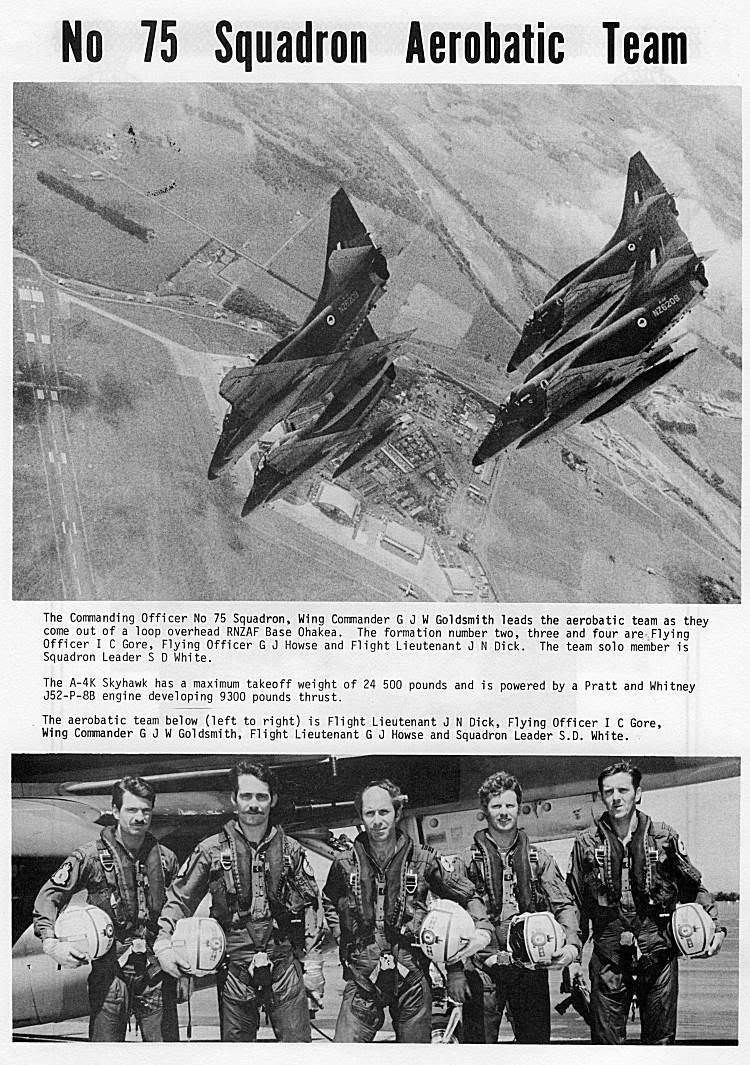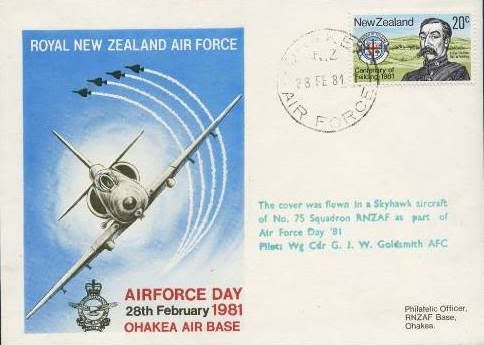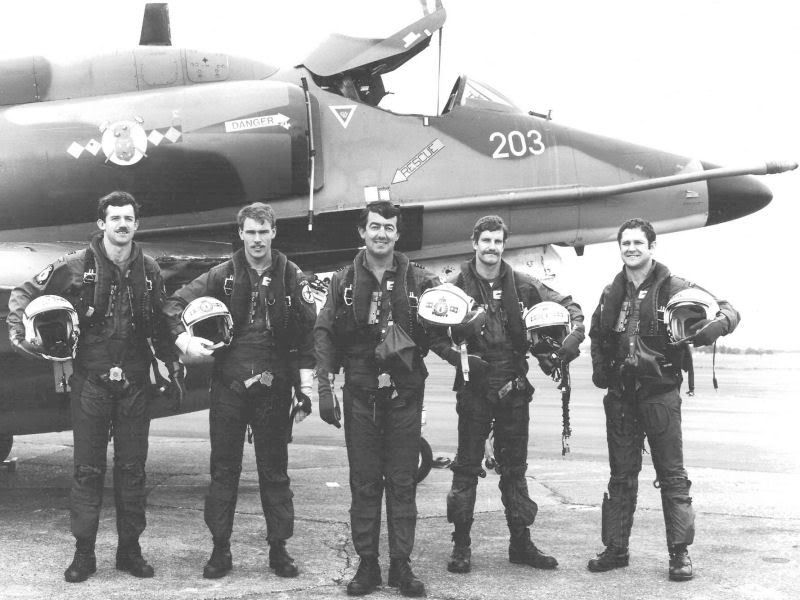
New Zealand Airshow Display Teams
RNZAF Teams
Please Note: Where known, the full name of the airmen appears on their first entry on this page, and if
they appear again subsequently down the page, their name is reduced to the more informal version
The 1950's No. 75 Squadron Vampire Aerobatic Team Display Dates Venue Pilots Notes
The 1953 No. 75 Squadron Vampire Aerobatic Display Team__________________Vampire29th of July 1953
_
_15th of Sep 1953
Air Display at RNZAF
Station Ohakea of
visit of Prime MinisterBattle of Britain Day
Flt Lt J.E. Woods
The 1954 No. 75 Squadron Vampire Aerobatic Display Team__________________Vampire19 Feb 1954
_3rd of May 1954
1954
_
_Formation Flypast
(Location Unknown)Royal Salute
National Aero Club
Pageant , Masterton
(Three Vampires)Flt Lt J.E. Woods
?
?
The 1955 No. 75 Squadron Vampire Aerobatic Display Team__________________Vampire19th of Feb 1955 Air Force Day 1955 F/O Stuart McIntyre
Flt Lt Michael Gordon Beavis
F/O Alan Dyer
Sgt James "Jim" Shaw
No. 1
No. 2
No. 3
No. 4
Note:Stuart McIntyre was a member of this team and he remembers:
"I was in one of the 14 Sqn Teams in Cyprus and when I returned to NZ in 1954, was initially, in the first 75 Sqn team formed by the OC, Sqn Ldr Norm Curtis. He was an RAF exchange officer but as he hadn't done any formation aeros he decided to give me the lead and we performed at Air Force Day at Ohakea on 19 Feb 1955.
Flt Lt Mike Beavis was an RAF exchange officer (he did become an Air Marshal and a knight -perhaps it was recognizing his bravery flying No. 2 to me!)"
The 1958 No. 75 Squadron 'Jetobatics'
Vampire Display TeamFormed in 1958 for the RNZAF's 21st Anniversary Airshow at Ohakea, four Vampires from No. 75 Squadron RNZAF made up this graceful team that thrilled the crowds and captured the imagination of the public. One of the four pilots was Trevor 'TT' Bland MNZM, AFC, well known today as the President of New Zealand Warbirds Inc.
Geoff Bentley wrote in his book RNZAF - A Short History that;
"The remarkable quality of this aerobatic flying was admirably captured in the award-winning film Jetobatics, which was released by the National Film Unit that year. Oddly Enough, Jetobatics - the word was coined by the film-makers and slipped readily into the language - was not programmed at all; it was an after-thought or, more correctly, a by-product of the black-and-white documentary film, The Eventful Years, then being made to mark the RNZAF's first twenty-one years.The idea of a second film, devoted solely to jet aerobatics, was born one evening at Ohakea when Bob Lapresle, the film director, the late John Hutchinson, the chief cameraman, and the RNZAF's public relations director were working on the flying sequences of The Eventful Years. It was a particularly happy inspiration from the Air Force's point of view because it introduced military aviation at its spectacular best to audiences large and small in every corner of New Zealand. Abroad it won a film award and lead the Royal Rhodesian Air Force to have a similar film made. It was also a monument to John Hutchinson's great skills as a cameraman and his unflagging interest in the air forces which he had served."
Also noted in Bentley's book was the fact that following the display by the Jetobatics team on the 29th of March 1958, The USAF's General Curtis LeMay stated, "That Vampire team of yours put on the finest display of aerobatics I have ever seen in my life."
A small portion of this documentary "Jetobatics" appeared later in the NZNFU film "RNZAF: Fifty Years" in 1987, and a longer sequence appeared in the TVNZ documentary A Shed Will Be Necessary (also 1987). It is stunningly beautiful - a masterpiece of flying and film work, and I find it quite mesmerising to watch.
After the Ohakea airshow, the team toured New Zealand displaying at all the major airports. Does anyone have further details of these displays, like venues and dates? If so, I'd love to hear from you please - contact me
Display Dates Venue Pilots Notes
The 1958 No. 75 Squadron "Jetobatics" Team _____________________________Vampire29th of Mar 1958
_RNZAF 21st Anniversary Airshow, Ohakea Flt Lt John Clark Buckmaster
Fg Off Adam Anderson
Flt Lt Colin William Rudd
Fg Off Trevor Thomas Bland
No. 1
No. 2
No. 3
No. 4
Note:Thanks to Barry Flavall for information on the team members of the 1958 'Jetobatics' team
By Mid 1958 No. 75 Squadron began converting to the English Electric Canberra bombers in the UK, and they served on the type in Singapore for several years, so this spelled the end of the Vampire teams for some time, till 1963.
The 1958 No. 75 Squadron Vampire Display TeamDisplay Dates Venue Pilots Notes
The 1958 No. 75 Squadron Team _____________________________Vampire26th of Oct 1958
Rangiora Airfield Opening F/Lt Mike Palmer
F/Lt Colin Rudd
F/Lt Barry Gordon
F/Lt J.M. Terry
F/O Tom Enright
No. 1
No. 2
No. 3
No. 4
Solo
Note:I am assuming this was a post-Jetobatics No. 75 Squadron team, rather than No. 14 Squadron.
The No. 75 Squadron Canberra Display Team
Geoffrey Bentley's RNZAF - A Short History shows a photo of the crews from the four No. 75 Squadron Canberras that attended the Philippine Aviation Week at Manila in 1959, and took part in the air display. One of the men in that photo is former RNZAF navigator Peter Pennell, who has kindly forwarded some memories of his taking part in Canberra display teams with the RNZAF - see below the 1959 listing.
Dates Venue Pilots and Navigators Notes
The 1958 No. 75 Squadron Canberra Display Team14th Dec 1958
_11th Annual Philippine
Aviation Week, ManilaSqn Ldr Geoffrey Reid Burton Highet
Flt Lt Colin Morris Hanson
Flt Lt Robert Fraser Ward
Pilot
Navigator
Eng Off
Flt Lt David Manson Crooks
Flt Lt Arthur Ronald Lawrence 'Ron' Russell
Wing Commander Voss
Pilot
Navigator
Passenger
Flt Lt Guy Xavier Edwin McLeod
P/O Peter Craig Pennell
F/O Stephen England Gillingham
Pilot
Navigator
Spare Pilot
Flt Lt Ian Albert Hutchins
Flt Lt Patrick Neville
F/O Denis John McMahon
Pilot
Navigator
Spare Nav
Note:
The 1959 No. 75 Squadron Canberra Display Team29th Nov 1959
_12th Annual Philippine Aviation Week, Manila International Airport
Sqn Ldr Geoffrey Reid Burton Highet
Flt Lt Stuart William Quayle
Flt Lt Robert Fraser Ward
Pilot
Navigator
Eng Off
Flt Lt John Lewis Nicholson Harris
F/O Peter Craig Pennell
Pilot
Navigator
Flt Lt Guy Xavier Edwin McLeod
F/O Denis John McMahon
Pilot
Navigator
F/Lt Arthur Ronald Lawrence 'Ron' Russell
Flt Lt Sydney Arthur 'Tony' Williams
Flt Lt Douglas Murray Dallison
Pilot
Navigator
Spare Pilot
Note:Canberra WF915 was flown by Ron Russell and Tony Williams to Manila International Airport to park up as the static aircraft. Accompannying them was Doug Dallison who was to be the team commentator. The other three crews flew a team display, operating out of Clark Air Force Base.
Groundcrew, flown up to the Philippines by No. 41 Squdron RNZAF in a Bristol Freighter, were:
F/Sgt H.T. Cosgrove
Sgt John Nigel Bruce (Radar Fitter)
Sgt Kenneth Arthur Grosse (Engine Fitter)
Sgt Douglas William Victor Hill (Armourer Fitter)
Sgt Ross McCabe
Sgt William Robinson (Airframe Fitter)
Cpl Sthephen Le Gros (Instrument Fitter)
Cpl R.G. McGregor
Cpl Norman Sawyers Ryder (Electrical Fitter)
LAC Basil Joseph Brosnahan (Engine Fitter)
LAC Peter Garth Campbell (Communications Mechanic)
LAC Anthony Norman Cooper (Armourer Fitter)
LAC Neville Peter Hancock (Electrical Fitter)
LAC Barry Mitchell Hawker (Metal Worker)
LAC C.J. Hempstead (Radar Fitter)
LAC Donald John Lamb (Instrument Mechanic)
LAC Christopher Robin Larson (Airframe Fitter)
LAC Jack Edward Moon (Airframe Mechanic)
LAC Trevor John Odering (Airframe Fitter)
LAC George McDonald Orsbourne (Engine Mechanic)
LAC Ross Edward Nyberg (Engine Mechanic)
LAC S.C. Robinson
LAC Allan Charles Rodgers (Electrical Mechanic)
LAC Ralph Charles Sandford (Engine Mechanic)
LAC John Ross Walton (Airframe Fitter)Navigator Peter Pennell remembered:
"The Canberra display in Manila was one of two consecutive displays that I took part in, the first year 1958 with John Harris, and the second 1960 with Geoff Highet who as Squadron Commander did the solo display. not a dedicated team as such, just a detachment with 4 aircraft doing simple formation flypasts, then the leader doing a solo display which included rolls and loops, and very low, very fast runs....."

The 1959 team from No. 75 Squadron who performed at Manila.
From left are F/O Peter Pennell, Sqn Ldr Geoff Highet,
Flt Lt Ron Russell, Flt Lt Tony Williams, Flt Lt John Harris,
Flt Lt Stu Quayle, Flt Lt Guy McLeod and supposedly F/O Phillip 'Tex' Rickard.
The 1960 No. 75 Squadron Canberra Display Team________________________Vampire1960
_13th Annual Philippines Aviation Week, Manila
Sqn Ldr Geoffrey Highet
F/O Peter Pennell
Sqn Ldr Baker
Pilot (solo)
Navigator
Signals Off
Flt Lt Smith
Flt Lt Barry Ernest Gilliver
LAC James Gavin Kyles
Pilot
Navigator
Passenger
Flt Lt Ian Hutchins
Flt Lt Stu Quayle
Flt Lt Colin Ernest Baird Papps
Pilot
Navigator
Admin Off
Flt Lt Guy Mcleod
F/O Philip John 'Tex' Rickard
F/Sgt Burke (NCO i/c Servicing)
Pilot
Navigator
Passenger
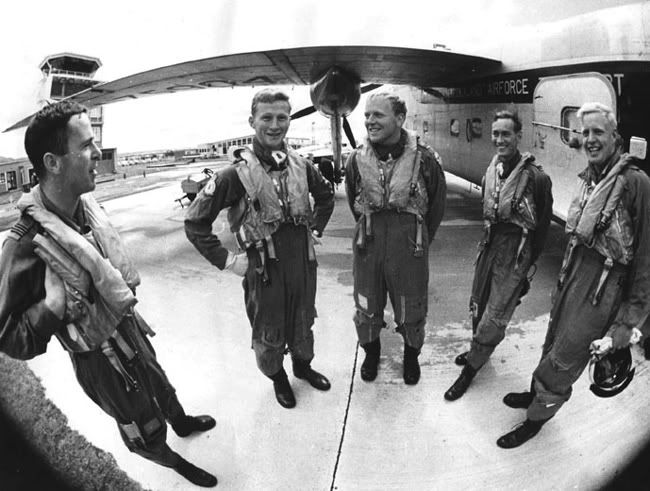
Above: Not a Vampire team as such, but several members of various teams seen here. Submitted by Ross Ewing, he says: "I'm not sure where this photo was taken (Hamilton or Whangarei?) but it was using a fish-eye lense! (hence the marked 'droop' of the Bristol Freighter's wing!). On the left is the No 75 Vampire Sqn Ops Flt Cdr, Barry Flavall, and on the right are the four Vampire Plt Offs who had all just come off No 36 Aircrew Course as the Vampires became reactivated. They are (left to right) Roger Henstock, Ross Ewing, Rick Histed and Graham Lloyd."
| The 1960's No. 75 Squadron Vampire Aerobatics Teams | |||
|---|---|---|---|
| Display Dates | Venue | Pilots | Notes |
|
|||
29th of Nov 1963 Feb 1964 8th of Feb 1964 15th of Feb 1964 Feb 1964 Feb 1964 22nd of Feb 1964 |
Flypast for CFS (RAF) RNZAF Wigram RNZAC Pageant, Napier Airshow Palmerston North Feilding Air Force Day |
Sqn Ldr Brian Stanley-Hunt F/O Graham Robert 'Snow' Lloyd F/O Kenneth Brooking RAF Flt Lt Frederick Barry Flavall Flt Lt Peter McDonald Rhodes |
No. 1 No. 2 No. 3 No. 4 No. 5 |
|
|||
|
|||
To see full coverage of the Air Force Day 1964 Click on the cover below to go to scans of the official magazine on my forum
|
|||
|
|||
| 13th of Mar 1965 _ _ |
Royal New Zealand |
Flt Lt Barry Flavall Fg Off Ross Lithgow Ewing Fg Off Graham Lloyd? _______________________ |
No. 1 No. ? No. ? No. ? |
|
|||
|
|||
29th of Jan 1966 |
Official Opening of the Auckland International Airport, Mangere |
Flt Lt Larry Olsen F/O Angus "Gus" Kingsmill F/O Ross Ewing F/O Barry Mitchell Flt Lt Peter Rhodes (solo) |
No. 1 No. 2 No. 3 No. 4 No. 5 |
|
|||
|
|||
1966
|
Sqn Ldr Colin Rudd F/O Gus Kingsmill F/L John Murray Denton F/L Larry Olsen |
No. 1
|
|
|
|||
16th Mar 1967 3rd of May 1967 11th of Oct 1967 3rd of Nov 1967 |
Wanganui Whenuapai Gisborne Tengah |
Sqn Ldr Colin Rudd Arthur Edmund Dovey F/L John Denton F/L Larry Olsen |
No. 1 No. 2 No. 3 No. 4 |
3-4 March 1967 8th of Aug 1967 |
Opening of New Display for RNZAF Spitfire |
Sqn Ldr Colin Rudd F/L Larry Olsen F/O Murray Thornton Whineray Sqn Ldr Trevor Bland |
No. 1 No. 2 No. 3 No. 4
|
|
|||
|
|||
11th of Feb 1968 23rd of Mar 1968 6th of Apr 1968 6th of May 1968 8th of May 1968 Sept 1968 |
Ardmore Display for 1914-1918 Tauranga Air Pageant Kerikeri Kaikohe Tauranga |
Sqn Ldr John Alan Scrimshaw F/O Dave Bevan Flt Lt Roger Ernest Henstock F/O Ross Ewing |
No. 1 No. 2 No. 3 No. 4 (s) |
|
|||
The Yellow Hammers
A team from No. 75 Squadron RNZAF flying de Havilland Vampires the 1968/69 season
Display Dates Venue Pilots Notes
The 1969 Yellow Hammers Team __________________________________________Vampire26th of Jan 1969
Week of
16-23 Feb 1969
__22nd of Feb 1969
_9th of Mar 1969
_26th of Mar 1969
26th of Mar 1969
27th of Mar 1969
_28th of Mar 1969
_
_3rd of May 1969
_
_4th of May 1969
_
_
_
Wairoa Airshow
Two aerobatic
displays over
RNZAF OhakeaRNZAC Pageant,
TaurangaWanganui Aero
PageantRNZAF Te Rapa
RNZAF Auckland
RNZAF
WoodbourneRNZAF Wigram
for Graduation of
No. 51 Pilots CourseOps Group Open
Day, RNZAF
WhenuapaiDisplay for
Exercise Kea Claw,
New Plymouth
(17,000 spectators)Sqn Ldr William Ross Donaldson
F/O David Bevan
F/Lt Kenneth Arthur Gayfer
F/O Mike Callinan
F/O Peter Tweedie Waller (solo)
No. 1
No. 2
No. 3
No. 4
No. 5
Note:This team first formed during the week of the 12th to 19th of January 1969. They performed their first display at Wairoa in January as seen above, and then during the week of the 16th to 23rd of February 1969 the team adopted the name of the Yellow Hammers.
Former 'Yellow Hammers' team member Ken Gayfer recalls:
"In 1969 I became training officer at No. 75 Sqn and slotted into the number three position in the Vampire display team. I suggested to the CO and leader of the team that “Yellow Hammers” might be a good name for the team based upon the squadron crest which contained crossed yellow hammers. All the team agreed and that is what it remained until disbandment following the arrival of the A4's."
Ross Ewing says:
"The name "The Yellow Hammers" came into use when the next formation aerobatic team leader, Sqn Ldr Ross Donaldson, took over. That name was used for his team alone. This was about 1968. Sqn Ldr Donaldson was then posted to the US Navy (around 1969) to become an instructor on Skyhawks.
During the 29th and 30th of April 1969 the team's display practice was filmed
for Northern Television's Town and Around news programme. This network broadcast to the upper North IslandDuring the week of the 25th to 31st of May 1969 the team's close formation practice display was filmed by the NZBC Film Unit, making a film about Jet Aerobatics. The chase-plane two-seat Vampire carrying the cameraman was flown by Trevor Bland.
A display scheduled for the Air Officer Commanding on the 4th of June 1969 had to be cancelled due to bad weather
On the 13th of June 1969 the team leader and squadron commander, Squadron Leader Ross Donaldson, was posted out of the squadron to go to the USA where he would convert onto the McDonnell Douglas A-4 Skyhawk in preparation for the arrival of the RNZAF's new A-4K's. This ended the "Yellow Hammers" team. Another team formed within three months but they were no longer known by that name and only one member of this team remained within its ranks (see below)
Personal Aircraft flown by this team (with the pilot's name's stencilled on the side in 1 inch lettering near the unique Yellow Hammers logo, were as follows:
_
Ross Donaldson
Dave Bevan
Ken Gayfer
Mike Callinan
Pete Waller
_NZ57__
NZ5770
NZ57__
NZ5765
NZ57__Any help is filling the blanks on the serials would be appreciated please.
___________________________________________________________________
The Late 1969 No. 75 Squadron Vampire Aerobatic Team Display Dates Venue Pilots Notes
The No. 75 Squadron Vampire Aerobatics Team - 1969/70________________________Vampire11 October 1969
_Cook Bicentenary
Celebrations, GisborneSqn Ldr John Scrimshaw
Lt Cmd Fred P. Myers (USN)
F/Lt Ken Gayfer
F/Lt Graeme Robert Thomson
F/O Ross Ewing (solo)
No. 1
No. 2
No. 3
No. 4
No. 5
Notes:This team immediately followed the Yellow Hammers. Ross Ewing states:
"Leadership of the Vampire team was then (from mid-1969) taken over by Sqn Ldr John Scrimshaw until he departed in January 1970 to the US to pick up the A-4K Skyhawks (he was in charge of the detachment). He did not re-adopt the name The Yellow Hammers, although his Vampire team was displayed on several occasions, including at the Cook Bicentenary Celebrations airshow at Gisborne in September 1969."
Graeme Thomson confirms this team:
"Yes, I was in the Vampire aerobatics team, but in the 1969 season, where the main focus was the Cook Bicentenary celebrations at Gisborne. I flew in that team as No. 4 with the others being (1) John Scrimshaw, (2) Fred Meyers (USN), (3) Ken Gayfer and Ross Ewing was #5 and solo pilot "
Jim Barclay remembers the Gisborne event in detail here:
"I saw mention of the Vampires at Gisborne for the Cook Bicentennial. This was Exercise Golden Kiwi at Gisborne 30 Sep 69 – 14 Oct 69. In this time we did 4 Diamond nine formation flypasts.
7 Oct practice – I was #7 of 9 flying NZ 5774
8 Oct Flypast the Naval Armada ( again 7 of 9 in NZ5770)
9 Oct Flypast Endeavour Park for the main civic ceremony in the main street of Gisborne (7 of 9 in 5774)
9 Oct Flypast Rugby Park for arrival of VIP (Gov General ?) ( 7 of 9 in 5774)
13 Oct Flypast Gisborne-Wairoa and then to Ohakea NZ5765.
Members of the first formation on 9 Oct were:
1 -Lt Cdr Fred P. Myers USMC exchange pilot
2 -P/O Ian ( Iggy) Wood
3- P/O P. Graham Bethell
4 F/O Graeme Thomson
5- F/L Ken A. Gayfer
6- F/L Ross L.Ewing
7 F/O Jim S. Barclay
8 F/O Ken G.Cox
9 F/O Jim R. Jennings & S/L Pat Neville (CO 14 Sqn) [or maybe he was W/C OC Base Wing Ohakea by then?]
The flypast was so low going past the dais that the white diesel smoke coming from five aircraft in the formation immediately enveloped the dignitaries. Fred Myers did a ‘low flyby' as leader of the formation but had forgotten that there were two layers of Vamps below him ! Passing the small Captain Cook ship mounted on top of the clock tower in the main street of Gisborne, Ross Ewing asked “ are you still there 9 ?” suggesting that 9 may have been scrapped off in the clock tower. Pat Neville flying as a passenger with Jim Jennings at the bottom of the formation later remarked that he could see the new pair of underpants he needed quite clearly in Hallensteins shop window as we passed by VERY low up the main street !
Iggy Wood had a blocked ear after the morning flight on 9 Oct but I don't know who took his place for the afternoon flight."
Thanks to Ross Ewing, Graeme Thomson and Jim Barclay for the information on this team.
The Last Ever No. 75 Squadron Vampire Display Team Display Dates Venue Pilots Notes
The No. 75 Squadron Vampire Aerobatics Team - 1970 __________________________Vampire7 March 1970
_RNZAC Pageant, Wanganui Sqn Ldr John Stewart Boys
Flt Lt John Denton
Lt Cdr Fred Myers USMC
No. 1
No. 2
No. 3
Notes:Stewart Boys remembers:
"In February 1970 after I was posted as CO 75 Squadron (Vampires) while the majority of the Squadron was in the US training on Skyhawks.
I was asked to form a three-man team, specifically to fly a display for the forthcoming RNZAC Pageant. A three-man team simply because there were only three of us left with the necessary experience. So here it is: The Last Vampire Team. Almost but not forgotten.
The last ever RNZAF Vampire display team. Left to Right: Lt Cdr Fred Myers USMC, Sqn Ldr Stewart Boys and Flt Lt John Denton
"By this stage, the Vampires were showing their age and there were difficulties with keeping them serviceable. On the day, I had to lead in a T11 as there were not enough single-seaters available.
The display went off well enough until the last manoeuvre - an upward bomburst in which the wing men were meant to roll outward on my command approaching the vertical and we would separately roll off the top and then turn and descend to complete a 50ft agl final pass in sequence.
Well, I gave my command "bomburst, bomburst go" on the R/T and continued, concentrating on keeping my own loop straight. When I rolled off the top, I was surprised to see the wing men still in some sort of formation trying to roll with me. My transmit button had failed and they did not get the call.
We recovered the formation and without proper communication had no option but to quietly fly away, change the lead by using hand signals and return to base.
A bit of an ignominious end to the glorious Vampire formation aerobatics era but probably the general public did not notice. Only the aficionados would have said something like "that's the first time I've seen a formation roll-off-the-top, and not very good either"."
The First Ever No. 75 Squadron Skyhawk Display Team
(Non-Aerobatic)Display Dates Venue Pilots Notes _
The No. 75 Squadron Skyhawk Display Team - 1972 ____________________________Skyhawk
1972
RNZAF Base Ohakea S/Ldr Ken Gayfer
Lt Cmdr Fred Myers
F/Lt Graeme Thomson
John Stuart Hosie
Roger Henstock (solo)
No. 1
No. 2
No. 3
No. 4
No. 5
Notes:Contrary to what the press stated in 1981 about the Graeme Goldsmith-lead five-ship Skyhawk team at Air Force '81 being the first RNZAF A-4 team, pilot Ken Gayfer reports a little forgotten history. He actually formed and lead a team that flew the first formation routine of RNZAF Skyhawks. However, it was strictly a 'non-aerobatic team'. See his words here:
"In 1970 I went to the U.S. with the first group of 10 to be trained on the A4 in the post of training officer. When John Hosie joined the squadron he and I tried out some formation aerobatics to see if an A-4 team could be developed. We decided it was suitable but the AOC at the time was not convinced.
Instead, we were asked to put on a 15 minute display without formation aerobatics!! I led this first A-4 display team and, in order to comply with the “no aerobatics” directive, tongue firmly in cheek, we dreamt up a manoeuvre we called ‘ripple roll' – individual aileron rolls in ‘looseish' echelon, each member rolling a fraction of a second after the one before - an adaptation of the RAF Red Arrows ‘Twinkle Roll'. Later, long after I left the squadron, a very successful formation team was authorised and formed which became Kiwi Red.
Sorry, my second log book containing all A4 time was destroyed in a warehouse fire whilst our personal effects were in storage when we were on overseas posting. Can't remember venue or dates but vaguely remember Hamilton as a possibility. Fairly certain it was a team of five with Roger Henstock doing the solo."
Graeme Thomson adds more, confirming this little known team:
"After returning from training at USN Cecil Field in early 1970, the first Skyhawk aerobatics team was formed briefly in 1972, where I flew as #3 with (1) Ken Gayfer, (2) Fred Myers and (4) and solo Roger Henstock. After that in late 1972 I went to helicopters to finish my RNZAF time and then to commercial aviation with Air NZ briefly and then Cathay Pacific.
The Skyhawk team was certainly established in 1972 initially, but only for a couple of displays at Ohakea."
The No. 75 Squadron Skyhawk Aerobatic Team
|
|||
|---|---|---|---|
| Display Dates | Venue | Pilots | Notes |
|
|||
28th of Feb 1981 |
Air Force Day Airshow |
W/C Graeme James Wharton Goldsmith Sqn Ldr Stewart D. White Flt Lt John Nicholas Dick Flt Lt Gavin John Howse F/O Ian Clifford Gore |
|
|
|||
| 31st of Jan 1981 _ __ _ |
Hawkes Bay Earthquake 50th Anniversary Airshow, Napier Airport (Two TA-4K's only, probably from this team?) |
|
|
|
|||
_______________
|
_______________________ | Wg Comm John Willis Lanham F/O Herbert Bruce Keightley ? ? ? |
Sqn CO
_
|
|
|||
26-27 Mar 1983 10 Apr 1983 17 Apr 1983 |
Air Extravaganza, Wanganui RNZAF Base Woodbourne |
Wg Comm John Lanham (Sqn CO) F/O Herb Keightley F/O Glenn Colin Stewart Flt Lt Francis Stanton Sharp Flt Lt Steven Douglas Pilkington |
No. 1 No. 2 No. 3 No. 4 No. 5 |
|
|||
|
|||
July 1986 1986 6th of Oct 1986 1986 |
Rarotonga Airport, Cook Is. Tonga Royal Australian Navy's RMAF Kuantan, Malaysia |
Wg Comm Frank Sharp Flt Lt Peter King F/O Donald Laming Flt Lt Craig Jonathon Wylie "Rosoe" Tanner Sqn Ldr Gavin Howse F/O Nigel Kenneth Milne |
No. 1 No. 2 No. 3 No. 4 No. 5 No. 6 |
|
|||
|
|||
28th and 29th of 1st of April 1987 4th and 5th of 11th and 12th of |
Christchurch International RNZAF 50th Anniversary, RNZAF 50th Anniversary, RNZAF 50th Anniversary, |
Wg Cdr Frank Sharp F/O Peter Roydon Turvey F/O John Gordon Benfell F/O Philip William Wilson Sqn Ldr Colin Maurice Rippey Flt Lt Stephen John Moore |
No. 1 No. 2 No. 3 No. 4 No. 5 No. 6 |
|
|||
|
|||
|---|---|---|---|
| Display Dates | Venue | Pilots | Notes |
|
|||
__Red 1 __Red 2 __Red 3 __Red 4 __Red 5 __Red 6 |
Wing Commander Frank Sharp Flying Officer Peter King Flying Officer Don Laming Flight Lieutenant Craig 'Roscoe' Tanner Squadron Leader Gavin Howse Flying Officer Nigel Milne |
||
Australian Bicentennial Airshow, Nissan Mobil 500 Race Wellington Waterfront |
12-16 of October 1988 24th of October 1988 |
_ Televised |
|
|
|||
|
|||
__Red 1 __Red 2 __Red 3 __Red 4a __Red 4b __Red 5 __Red 6 |
Wing Commander John Stephenson 'Boss' Bates Flight Lieutenant Barry John 'Patch' Nelson Flying Officer Graeme Edward 'Dobbo' Dobson Flying Officer Graham Thomas "Crater" Carter (killed in a practice) Flying Officer Craig Alexander Mitchell (replaced Graham Carter) Flight Lieutenant Herbert Bruce 'Herb' Keightley Flight Lieutenant Peter King |
||
Battle of Britain Day Flypast, low level over lower RNZAF Woodbourne 50th Anniv. Open Day RNZAF Ohakea 50th Anniversary Open Day Full display over Ohakea (first full display for Manfield Motorcycle Race Track Special Olympics, Queen Elizabeth College Nissan/Mobil 500 Race Wellington Cultural Festival on the Waitemata Harbour Opening of Commonwealth Games, Mt Smart RNZAF Whenuapai To Hamilton Airport (for 5 Day Deployment) Rotorua, Kawerau and Whakatane Displays over Tauranga and Te Puke Raglan, Te Kuiti, Tokoroa & Hauraki Plains Display at Hamilton, then returned Whenuapai Closing of the Commonwealth Games, Mt Smart Whitbread Around The World Yacht Race Display over Orewa Waitangi Day Celebrations 150th, Waitangi Royal New Zealand Aero Club Pageant, Timaru Displays over Taupo and Wanganui Displays over the Woodville Festival,the Bulls Anniversary Celebrations and Apiti Displays over Wairoa and Napier Displays over Hastings and Dannevirke Display at New Plymouth Display at Marton Ardmore Airshow Invercargill, Balclutha, Bluff and Stewart Is. Display over St Kilda Beach, Dunedin Display at Wigram, Christchurch RNZAF Woodbourne Ultrascan Appeal Airshow Display at Wigram Southern Cross Airshow, Flypasts in North Canterbury in the morning Hokitika, South Marlborough, Westport, Display over Nelson Harbour Gisborne Airshow Display over Wellington Harbour RNZAF Ohakea, for 75 Sqn's 50th Anniversary |
15th of Sept 1989 16th of Sept 1989 29th of Sept 1989_ 6th of Nov 1989 19th of Nov 1989 2nd of Dec 1989 2nd-3rd of Dec 1989 24th of Jan 1990 (am) 24th of Jan 1990 (pm)_ 25th of Jan 1990 26th of Jan 1990 26th of Jan 1990 27th of Jan 1990 (am) 27th of Jan 1990 (pm) 28th of Jan 1990 3rd of Feb 1990 4th of Feb 1990 5th of Feb 1990 6th of Feb 1990 17th of Feb 1990 _ 23rd of Feb 1990 24th of Feb 1990 27th of Feb 1990 28th of Feb 1990 1st of March 1990 2nd of March 1990 4th of March 1990 13th of March 1990 14th of March 1990 16th of March 1990 17th of March 1990 18th of March 1990 20th of March 1990 21st of March 1990 22nd of March 1990 25th of March 1990 28th of March 1990 30 & 31 March 1990 |
5 16 29 6 19 2 Televised 2 Televised Televised _
Televised
Televised
4 1
2
- - - 3-
Televised - |
|
|
|||
Back To Airshow Archive Homepage


